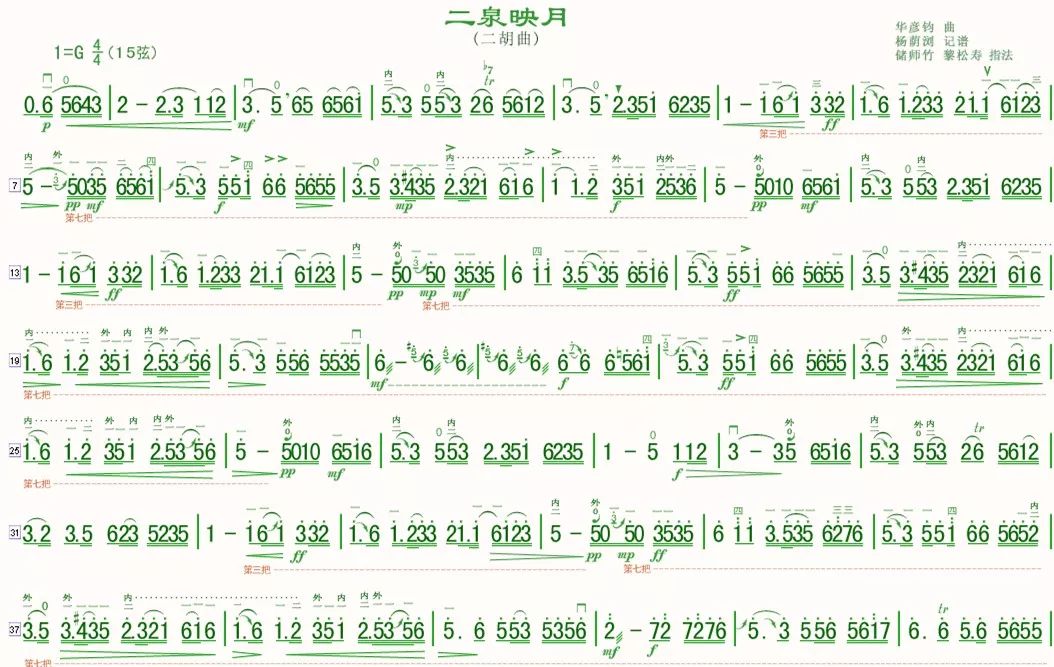Detailed graphic teaching of Erhu famous song "Erquan Reflecting the Moon"
The following is the simplified score of Erhu Solo from "Erquan Reflecting the Moon". This piece is in the key of G, but the tuning is on the (1 5) string. The sheet music and exercise instructions are as follows:


1. The song "Er Spring Reflecting the Moon" uses four positions to perform, such as:

..The whole piece is played in the first position at the beginning.
..beats 1-2 of bars 5 to 7 are played in the third position.
..the third beat of the 7th bar enters the seventh position.
..the second beat of bar 74 starts in the tenth position.
....
In the whole spectrum, the labeling of each position is very clear. On the example in the picture above, the corresponding handle can be found.
A variety of hand-changing techniques are used in the song, such as "open string change", "slip finger change", "shift finger change", "jump finger change", etc. .
2. The finger-sliding technique used in the song "Erquan Yingyue"
1. Forefinger minor third sliding finger

In the 5th to 6th bars of the song, the technique of expanding the index finger upwards is used to realize the "small third-degree sliding finger". When practicing, the left hand is positioned in the third position, that is, the position of the index finger does not change during the sliding process.
Note: "6-1`" (*1) in the 5th measure is the portamento of the index finger ascending a minor third, and the portamento should be just right. In the first beat of measure 6, "1`-6" (*2) is a portamento of the index finger descending a minor third, and the glide effect is more obvious. For the next downward minor third portamento (*3), the portamento has been reduced, and it is sufficient to add a little bit.
"Minor third degree same-finger sliding" can be divided into: "upward minor third-degree same-finger sliding" and "downward minor third-degree same-finger sliding". The "Tiger's Mouth Fixing" method of sliding fingers is used in the song "Erquan Reflecting the Moon". This kind of sliding finger is the "fixed handle sliding finger" technique.
2. Ring finger minor third slide

In the 35th bar (*1), the method of expanding the ring finger downward is used to realize the "small third-degree sliding finger". At this time, the tiger's mouth should be stable on the seventh position when the ring finger is sliding.
3. Poly Glide

The two notes on the first beat of measure 8 (*1) are a "poly portamento" technique. "Poly portamento" is a kind of portamento that mixes two portamentos together, and it belongs to "connected finger slides". The notes in the "stub slide" should be played with a single bow.
3. The technique of "small third index finger sliding" can be practiced as shown in the figure below.

4. Points to pay attention to in fingering
The "5" tone in "Erquan Reflecting the Moon" is played in a variety of ways:

In bar 49, three techniques for pressing the "5" note are used:
--The technique of pressing the middle finger (*1 place)
--Press the inner string with your little finger (*2 places)
--Using open-air strings (*3 places)
The outer string sound is realized by the method of "bringing up"

The 11th and other subsections use the technique of "bringing up" with the left finger. The specific techniques are:
After pressing the first and second beats with your left index finger, when you leave the strings, gently scratch the strings to bring out the "5" empty string sound (*1) in the third beat. In the moment before it is brought up, the bow of the right hand should be attached to the inner string, so that the "5" sound brought up has a certain sound quality and volume. In addition, the index finger, middle finger or ring finger is generally used to bring the sound.
Note: The sound of "5" on the empty string is not pronounced by wiping the bow, nor by plucking the string. The severity of the attack should be determined according to needs. There are seven places in this score that use the method of "bringing up".
Note: Some versions use the method of hooking the outer string (plucking) with the left finger to achieve the "5" sound of the outer string in the above score.
The vibrato of "6" in "Erquan Yingyue"

The "6" sound in the third beat of the 3rd measure, this score adopts the technique of "minor second" vibrato (*1 place). This vibrato sounds much better as "6b76b7" than "6767".
5. Other aspects
To master the notation: the changing sound "#4", the accent "<", the comma (phrase pause, breath), the bow quiver, the bow, the extension, etc. in the phrase.

The bow of this song is "pull-pull-push". You can adjust the bow segment of the end of the song by using the gap of the unrest in the first measure of the end of the song, so as to pull the last three notes. The use of bowing is very important, especially the skills in the allocation of bow segments, and the knowledge is very deep. Different versions of bow fingering are also different.
 渝公网安备 50010702504639号
渝公网安备 50010702504639号